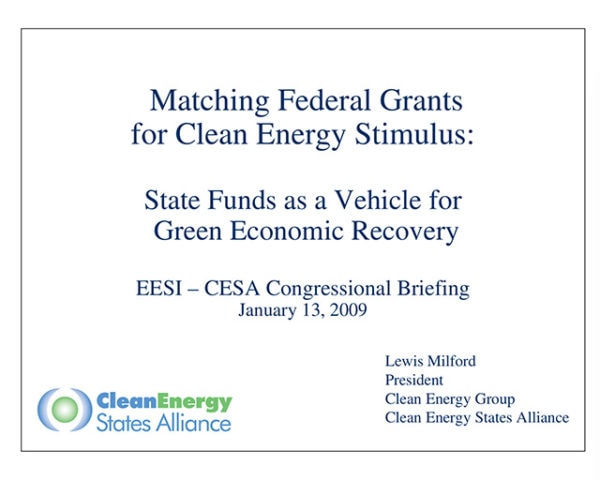
The Strategic Role of States in Supporting Clean Energy
CESA and EESI
On January 13, the Environmental and Energy Study Institute (EESI) and Clean Energy States Alliance (CESA) held a briefing to discuss the significant role that states are playing in developing and deploying clean energy technologies. As Congress considers economic recovery proposals, there are important lessons that can be learned from states on how a new federal/state partnership can accelerate the deployment of clean energy projects across the country and fuel the green economy. Many state governments view clean energy as a foundation of their environmental and economic development strategies and have taken leadership roles in implementing renewable energy initiatives and policies. This briefing released new data on the results of state activity in project deployment and describe the investment models, financing tools, market development strategies, and other policies powered by states to successfully stimulate technological innovation and move wind, solar, and biomass technologies out of the laboratory and into the mainstream. This briefing also offered specific recommendations to Congress on how the federal government working in partnerships with states can more effectively tackle the country’s energy, economic, and climate challenges.
- State policies and programs are the primary driving force leading the nation toward a cleaner, renewable energy future.
- Over the past ten years, CESA member agencies have spent about $1.5 billion on nearly 50,000 clean energy projects across the country, leveraging about $2.5 billion in additional clean energy investment.
- The freeze in credit markets and shrinking budgets have forced many states and private investors to put projects on hold. These are projects that are ready to go now – ready to create jobs, stimulate local economies, and reduce energy consumption and greenhouse gas emissions.
- Janet Joseph of the New York State Energy Research and Development Authority (NYSERDA) said “clean energy programs are investments and not costs.” For every $1 New York has spent toward clean energy product development, it has generated $3 in state domestic product.
- Private sector investors need a more stable policy environment in which to make long-term clean energy investment decisions. For example, production tax credits should be extended to 8 years for all renewable technologies (rather than in only one or two year increments), and they should be renewed on a rolling basis.
- State renewable energy and energy efficiency programs are in the best position to steer federal economic recovery funds quickly and effectively toward shovel-ready projects that will create jobs and stimulate local economies. Providing block grants to state clean energy funds and agencies should be a component of any economic stimulus package.
Speakers for this event included:
- Lew Milford, President, Clean Energy States Alliance (slides)
- Tom Plant, Director, Colorado Governor’s Energy Office (slides)
- Janet Joseph, Director of Clean Energy Research & Market Development, New York State Energy Research and Development Authority (NYSERDA) (slides)
- Peter West, Director of Renewable Energy, Energy Trust of Oregon (slides)
- Rob Sanders, Sustainable Development Fund Manager, The Reinvestment Fund (slides)
In addition to the speakers listed above, representatives from Alaska, California, Connecticut, Illinois, Maryland, Massachusetts, Minnesota, New Jersey, Ohio, Vermont, and Wisconsin were available to answer questions about their programs.
Resource Details:
Date: January 13, 2009
Type: Presentation
Topic(s): Finance
